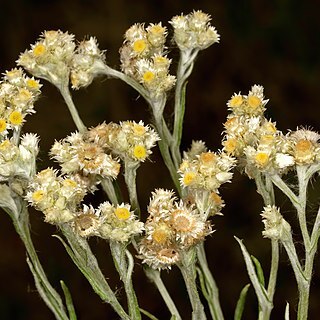Annual herb, stems simple or branching from the base, stiffly erect to c. 1 m, branching above into the compound inflorescence, loosely white-woolly, closely leafy. Leaves up to 80 x 4(-8) mm, oblong, oblong-lanceolate or lanceolate, apex subacute to acute, base broad, more or less cordate-clasping, scarcely decurrent, margins entire, often somewhat undulate, upper surface glandular, green drying brown, lower white-felted. Heads c. 4 mm long, broadly campanulate, several together in tight clusters, these arranged in a large corymbose panicle. Involucral bracts in c. 4 series, imbricate, innermost slightly exceeding the flowers, stereome undivided, lamina whitish, the outer 2 series white-woolly on the backs. Receptacle shortly honeycombed. Flowers c. 381-1118 cm our area, 135-415 ('female'), 10-30 ('bisexual'). Achenes c. 0.5 mm long, glabrous. Pappus bristles many, scabrid, bases cohering lightly by patent cilia. Flowering mainly between December and May, but as early as September.
Annual herb, up to 1 m high, erect. Leaves alternate, sessile; blade oblong, oblong-linear or linear, apex acute or subacute, main stem leaves not decurrent, at most base cordate-clasping; upper surface glandular, green, drying brown, lower surface white-felted, discolorous. Heads disciform, with up to at least 145 flowers, several in tight clusters, arranged in corymbose panicles. Involucral bracts ± 4-seriate, whitish, outer 2 rows white-woolly on backs, stereome undivided. Flowers: outer female florets many, filiform; disc florets few; whitish or yellow; Oct.-May. Fruit with cypsela ellipsoid, glabrous. Pappus of many barbellate bristles.
Erect, white-woolly, annual herb, up to 1 m high. Leaves alternate, sessile, oblong, oblong-lanceolate or lanceolate, apex subacute to acute, base cordate-clasping, not decurrent, margins entire, upper surface glandular, lower surface white-felted, discolorous. Capitula disciform, several together in tight clusters arranged in a large, corymbose panicle; involucral bracts whitish. Outer florets female, filiform, more than disc florets, yellowish. Disc florets tubular, yellowish. Flowering time Jan.-Mar. Pappus of barbellate bristles. Cypselae oblong, glabrous.
Annual herb, up to 1 m high. Leaves oblong, oblong-lanceolate or lanceolate, apex subacute to acute, base cordate-clasping, not decurrent, discolorous. Flowers whitish.

